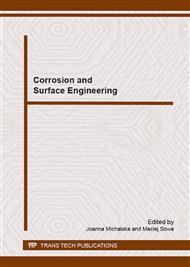[1]
R. Norsworthy, Causes of external corrosion on coated and cathodically protected pipelines, Corrosion 2009, March 22-26 (2009) Atlanta, GA.
Google Scholar
[2]
R.V. Aginey, Y.V. Aleksandrov, Study criteria ECP in disbondmend of insulation coating of pipeline, Territoriya NEFTEGAZ. 2 (2010) 23-26.
Google Scholar
[3]
R. Norsworthy, Non-shielding coatings: new regulations, World Pipelines, 10 (2010) 37-41.
Google Scholar
[4]
D. Kopitar, Z. Skenderi, T. Rukavina, Influence of Pressure on Water Permeability and Characteristic Opening Size of Nonwoven Geotextiles, J. Fiber Bioeng. Informatics 6 (2013) 103-115.
DOI: 10.3993/jfbi03201310
Google Scholar
[5]
R. Sarathi, S. Chandasekar, V. Sabari Giri, C. Venkatashaiah,R. Vermurugan, Analysis of surface degradation of high density polyethylene (HDPE) insulation material due to tracking, Bull. Mater. Sci. 27 (2004) 251-262.
DOI: 10.1007/bf02708514
Google Scholar
[6]
A.Q. Fu, Y.F. Cheng, Characterization of the permeability of a high performance composite coating to cathodic protection and its implications on pipeline integrity, Prog. Org. Coat. 72 (2011) 423-428.
DOI: 10.1016/j.porgcoat.2011.05.015
Google Scholar
[7]
Tom Jack, Fraser King, Yufeng Cheng, Robert Worthingham, Permeable Coatings and CP Compability, Proceedings of 4th International Pipeline Conference, September 29-October 3 (2002) Calgary Alberta Canada IPC2002-2726.
DOI: 10.1115/ipc2002-27267
Google Scholar
[8]
Douglas P. Riemer, Mark E. Orazem, Modeling coating flaws with non-linear polarization curves for long pipelines, Adv. Bound. Elem. Ser. 12 (2005) 225-259.
DOI: 10.2495/1-85312-889-9/09
Google Scholar


